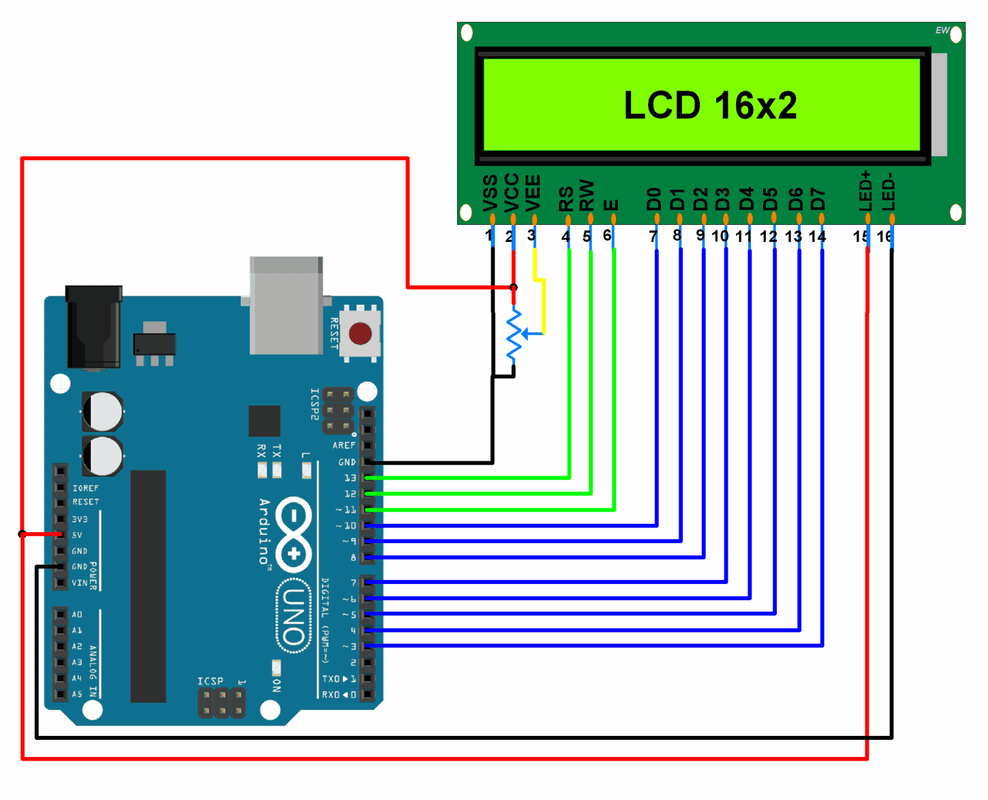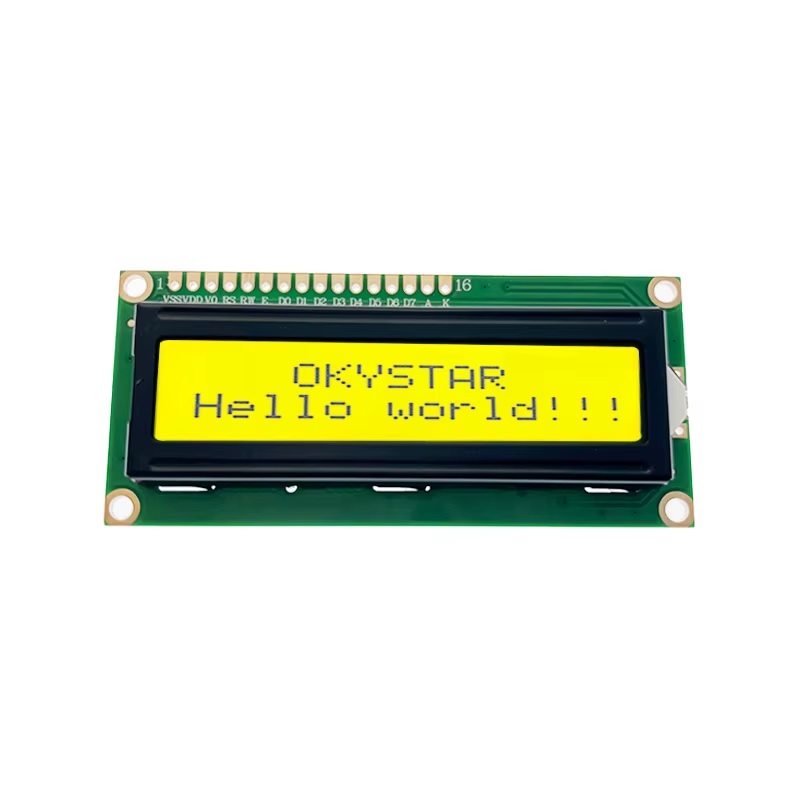Features:
- LCD display module with yellow backlight
- Wide viewing angle and high contrast
- Built-in industry standard HD44780 equivalent LCD controller
- Commonly used in copiers, fax machines, printers, industrial test equipment, routers, storage devices
- LCM type: Characters
- Display: 2 lines × 16 characters
- Voltage: 5V DC
- Module dimensions: 80mm x 35mm x 11mm
- Viewing area: 64.5mm x 16mm
Principle of Work:
The display operates using LCD technology, where liquid crystals change alignment under electric fields to control light passage. The HD44780 controller sends signals to activate specific character segments. The yellow LED backlight enhances visibility and is also controlled by the HD44780 to manage brightness and power consumption.
Pinout of the Module:

- Pin 1 (GND): Ground
- Pin 2 (VCC): +5V Supply
- Pin 3 (V0/VEE): Contrast control via a potentiometer (0-5V)
- Pin 4 (RS): Register Select (0 = Command, 1 = Data)
- Pin 5 (R/W): Read/Write (0 = Write, 1 = Read)
- Pin 6 (E): Enable signal
- Pins 7-14: Data lines D0-D7 (only D4–D7 used in 4-bit mode)
- Pin 15: LED+ (Backlight +5V)
- Pin 16: LED− (Backlight GND)
Applications:
- Embedded systems
- Instrumentation and industrial control
- Home automation (displaying temperature, humidity, etc.)
- Consumer electronics (MP3 players, digital cameras)
- Robotics (sensor data, system status)
- Educational and hobby electronics
Circuit Diagram:
- Connect GND to MCU ground
- Connect VCC to +5V
- V0 to potentiometer output for contrast adjustment
- RS, R/W, E to digital pins on MCU
- D0–D7 to MCU (only D4–D7 used in 4-bit mode)
- LED+ to +5V, LED− to ground

Library:
No additional library installation is needed. The LiquidCrystal library comes pre-installed with the Arduino IDE.
Example Code (Arduino):
#include <LiquidCrystal.h>
// Create LCD object: (RS, RW, E, D0-D7)
LiquidCrystal lcd(13, 12, 11, 10, 9, 8, 7, 6, 5, 4, 3); // 8-bit mode
// LiquidCrystal lcd(13, 12, 11, 6, 5, 4, 3); // 4-bit mode
unsigned char Character1[8] = {0x04, 0x1F, 0x11, 0x11, 0x1F, 0x1F, 0x1F, 0x1F}; // Custom Char 1
unsigned char Character2[8] = {0x01, 0x03, 0x07, 0x1F, 0x1F, 0x07, 0x03, 0x01}; // Custom Char 2
void setup() {
lcd.begin(16, 2); // Initialize LCD
lcd.clear(); // Clear display
lcd.createChar(0, Character1);
lcd.createChar(1, Character2);
}
void loop() {
lcd.setCursor(0, 0);
lcd.print("Hello!!!!");
lcd.setCursor(0, 1);
lcd.write(byte(0)); // Display custom char 1
lcd.write(1); // Display custom char 2
}
Technical Details:
- Operating voltage: 4.7V to 5.3V
- Operating current (no backlight): ~1mA
- Backlight color: Yellow
- Bezel size: 72mm x 25mm
- PCB dimensions: 80mm x 36mm x 10mm
- HD44780 controller
- Character size: 5x8 pixels
- Font dimensions: 0.125W x 0.200H
- Works in 4-bit and 8-bit modes
- Total pins: 16
Resources:
Comparison: LCD HD44780 vs. LCD I2C Module
- Connection: HD44780 requires multiple pins (RS, E, D0–D7); I2C uses only SDA and SCL.
- Simplicity: I2C greatly simplifies wiring and coding.
- Space Saving: I2C requires fewer connections, saving PCB space.
- Power Consumption: I2C modules are typically more power-efficient due to simpler communication.
Features:
- LCD display module with yellow backlight
- Wide viewing angle and high contrast
- Built-in industry standard HD44780 equivalent LCD controller
- Commonly used in copiers, fax machines, printers, industrial test equipment, routers, storage devices
- LCM type: Characters
- Display: 2 lines × 16 characters
- Voltage: 5V DC
- Module dimensions: 80mm x 35mm x 11mm
- Viewing area: 64.5mm x 16mm
Principle of Work:
The display operates using LCD technology, where liquid crystals change alignment under electric fields to control light passage. The HD44780 controller sends signals to activate specific character segments. The yellow LED backlight enhances visibility and is also controlled by the HD44780 to manage brightness and power consumption.
Pinout of the Module:

- Pin 1 (GND): Ground
- Pin 2 (VCC): +5V Supply
- Pin 3 (V0/VEE): Contrast control via a potentiometer (0-5V)
- Pin 4 (RS): Register Select (0 = Command, 1 = Data)
- Pin 5 (R/W): Read/Write (0 = Write, 1 = Read)
- Pin 6 (E): Enable signal
- Pins 7-14: Data lines D0-D7 (only D4–D7 used in 4-bit mode)
- Pin 15: LED+ (Backlight +5V)
- Pin 16: LED− (Backlight GND)
Applications:
- Embedded systems
- Instrumentation and industrial control
- Home automation (displaying temperature, humidity, etc.)
- Consumer electronics (MP3 players, digital cameras)
- Robotics (sensor data, system status)
- Educational and hobby electronics
Circuit Diagram:
- Connect GND to MCU ground
- Connect VCC to +5V
- V0 to potentiometer output for contrast adjustment
- RS, R/W, E to digital pins on MCU
- D0–D7 to MCU (only D4–D7 used in 4-bit mode)
- LED+ to +5V, LED− to ground

Library:
No additional library installation is needed. The LiquidCrystal library comes pre-installed with the Arduino IDE.
Example Code (Arduino):
#include <LiquidCrystal.h>
// Create LCD object: (RS, RW, E, D0-D7)
LiquidCrystal lcd(13, 12, 11, 10, 9, 8, 7, 6, 5, 4, 3); // 8-bit mode
// LiquidCrystal lcd(13, 12, 11, 6, 5, 4, 3); // 4-bit mode
unsigned char Character1[8] = {0x04, 0x1F, 0x11, 0x11, 0x1F, 0x1F, 0x1F, 0x1F}; // Custom Char 1
unsigned char Character2[8] = {0x01, 0x03, 0x07, 0x1F, 0x1F, 0x07, 0x03, 0x01}; // Custom Char 2
void setup() {
lcd.begin(16, 2); // Initialize LCD
lcd.clear(); // Clear display
lcd.createChar(0, Character1);
lcd.createChar(1, Character2);
}
void loop() {
lcd.setCursor(0, 0);
lcd.print("Hello!!!!");
lcd.setCursor(0, 1);
lcd.write(byte(0)); // Display custom char 1
lcd.write(1); // Display custom char 2
}
Technical Details:
- Operating voltage: 4.7V to 5.3V
- Operating current (no backlight): ~1mA
- Backlight color: Yellow
- Bezel size: 72mm x 25mm
- PCB dimensions: 80mm x 36mm x 10mm
- HD44780 controller
- Character size: 5x8 pixels
- Font dimensions: 0.125W x 0.200H
- Works in 4-bit and 8-bit modes
- Total pins: 16
Resources:
Comparison: LCD HD44780 vs. LCD I2C Module
- Connection: HD44780 requires multiple pins (RS, E, D0–D7); I2C uses only SDA and SCL.
- Simplicity: I2C greatly simplifies wiring and coding.
- Space Saving: I2C requires fewer connections, saving PCB space.
- Power Consumption: I2C modules are typically more power-efficient due to simpler communication.


